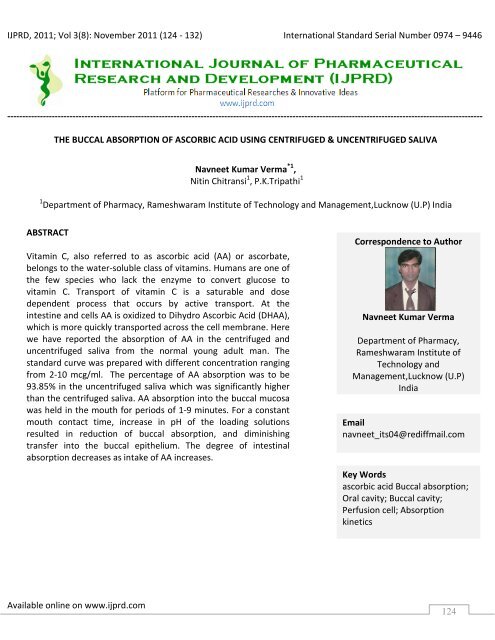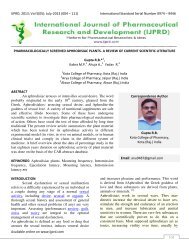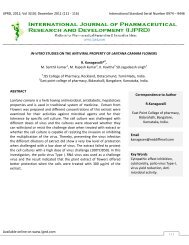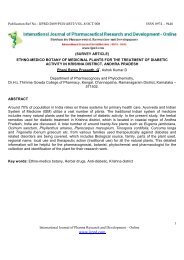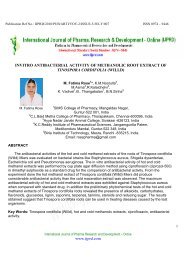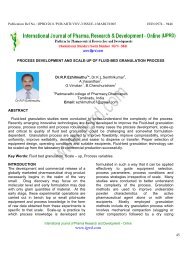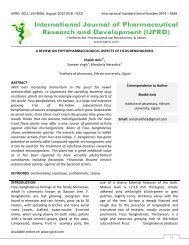the buccal absorption of ascorbic acid using centrifuged - IJPRD
the buccal absorption of ascorbic acid using centrifuged - IJPRD
the buccal absorption of ascorbic acid using centrifuged - IJPRD
You also want an ePaper? Increase the reach of your titles
YUMPU automatically turns print PDFs into web optimized ePapers that Google loves.
<strong>IJPRD</strong>, 2011; Vol 3(8): November 2011 (124 - 132) International Standard Serial Number 0974 – 9446<br />
----------------------------------------------------------------------------------------------------------------------------------------------------------------<br />
THE BUCCAL ABSORPTION OF ASCORBIC ACID USING CENTRIFUGED & UNCENTRIFUGED SALIVA<br />
Available online on www.ijprd.com<br />
Navneet Kumar Verma *1 ,<br />
Nitin Chitransi 1 , P.K.Tripathi 1<br />
1 Department <strong>of</strong> Pharmacy, Rameshwaram Institute <strong>of</strong> Technology and Management,Lucknow (U.P) India<br />
ABSTRACT<br />
Vitamin C, also referred to as <strong>ascorbic</strong> <strong>acid</strong> (AA) or ascorbate,<br />
belongs to <strong>the</strong> water-soluble class <strong>of</strong> vitamins. Humans are one <strong>of</strong><br />
<strong>the</strong> few species who lack <strong>the</strong> enzyme to convert glucose to<br />
vitamin C. Transport <strong>of</strong> vitamin C is a saturable and dose<br />
dependent process that occurs by active transport. At <strong>the</strong><br />
intestine and cells AA is oxidized to Dihydro Ascorbic Acid (DHAA),<br />
which is more quickly transported across <strong>the</strong> cell membrane. Here<br />
we have reported <strong>the</strong> <strong>absorption</strong> <strong>of</strong> AA in <strong>the</strong> <strong>centrifuged</strong> and<br />
un<strong>centrifuged</strong> saliva from <strong>the</strong> normal young adult man. The<br />
standard curve was prepared with different concentration ranging<br />
from 2-10 mcg/ml. The percentage <strong>of</strong> AA <strong>absorption</strong> was to be<br />
93.85% in <strong>the</strong> un<strong>centrifuged</strong> saliva which was significantly higher<br />
than <strong>the</strong> <strong>centrifuged</strong> saliva. AA <strong>absorption</strong> into <strong>the</strong> <strong>buccal</strong> mucosa<br />
was held in <strong>the</strong> mouth for periods <strong>of</strong> 1-9 minutes. For a constant<br />
mouth contact time, increase in pH <strong>of</strong> <strong>the</strong> loading solutions<br />
resulted in reduction <strong>of</strong> <strong>buccal</strong> <strong>absorption</strong>, and diminishing<br />
transfer into <strong>the</strong> <strong>buccal</strong> epi<strong>the</strong>lium. The degree <strong>of</strong> intestinal<br />
<strong>absorption</strong> decreases as intake <strong>of</strong> AA increases.<br />
Correspondence to Author<br />
Navneet Kumar Verma<br />
Department <strong>of</strong> Pharmacy,<br />
Rameshwaram Institute <strong>of</strong><br />
Technology and<br />
Management,Lucknow (U.P)<br />
India<br />
Email<br />
navneet_its04@rediffmail.com<br />
Key Words<br />
<strong>ascorbic</strong> <strong>acid</strong> Buccal <strong>absorption</strong>;<br />
Oral cavity; Buccal cavity;<br />
Perfusion cell; Absorption<br />
kinetics<br />
124
International Journal <strong>of</strong> Pharmaceutical Research & Development ISSN: 0974 – 9446<br />
INTRODUCTION<br />
Vitamin C, also known as L-<strong>ascorbic</strong> <strong>acid</strong>, is a watersoluble<br />
vitamin that is naturally present in some foods,<br />
added to o<strong>the</strong>rs, and available as a dietary supplement.<br />
Humans, unlike most animals, are unable to syn<strong>the</strong>size<br />
vitamin C endogenously, so it is an essential dietary<br />
component[1].<br />
Vitamin C is required for <strong>the</strong> biosyn<strong>the</strong>sis <strong>of</strong> collagen, Lcarnitine,<br />
and certain neurotransmitters; vitamin C is<br />
also involved in protein metabolism [1,2]. Collagen is an<br />
essential component <strong>of</strong> connective tissue, which plays a<br />
vital role in wound healing. Vitamin C is also an<br />
important physiological antioxidant [3] and has been<br />
shown to regenerate o<strong>the</strong>r antioxidants within <strong>the</strong><br />
body, including alpha-tocopherol (vitamin E) [4].<br />
Ongoing research is examining whe<strong>the</strong>r vitamin C, by<br />
limiting <strong>the</strong> damaging effects <strong>of</strong> free radicals through its<br />
antioxidant activity, might help prevent or delay <strong>the</strong><br />
development <strong>of</strong> certain cancers, cardiovascular disease,<br />
and o<strong>the</strong>r diseases in which oxidative stress plays a<br />
causal role. In addition to its biosyn<strong>the</strong>tic and<br />
antioxidant functions, vitamin C plays an important role<br />
in immune function [4] and improves <strong>the</strong> <strong>absorption</strong> <strong>of</strong><br />
nonheme iron [5], <strong>the</strong> form <strong>of</strong> iron present in plantbased<br />
foods. Insufficient vitamin C intake causes scurvy,<br />
which is characterized by fatigue or lassitude,<br />
widespread connective tissue weakness, and capillary<br />
fragility [1,2,4,6-9].<br />
The intestinal <strong>absorption</strong> <strong>of</strong> vitamin C is regulated by at<br />
least one specific dose-dependent, active transporter<br />
[4]. Cells accumulate vitamin C via a second specific<br />
transport protein. In vitro studies have found that<br />
oxidized vitamin C, or dehydro<strong>ascorbic</strong> <strong>acid</strong>, enters cells<br />
via some facilitated glucose transporters and is <strong>the</strong>n<br />
reduced internally to <strong>ascorbic</strong> <strong>acid</strong>. The physiologic<br />
importance <strong>of</strong> dehydro<strong>ascorbic</strong> <strong>acid</strong> uptake and its<br />
contribution to overall vitamin C economy is unknown.<br />
Oral vitamin C produces tissue and plasma<br />
concentrations that <strong>the</strong> body tightly controls.<br />
Available online on www.ijprd.com<br />
Approximately 70%–90% <strong>of</strong> vitamin C is absorbed at<br />
moderate intakes <strong>of</strong> 30–180 mg/day. However, at doses<br />
above 1 g/day, <strong>absorption</strong> falls to less than 50% and<br />
absorbed, unmetabolized <strong>ascorbic</strong> <strong>acid</strong> is excreted in <strong>the</strong><br />
urine [4]. Results from pharmacokinetic studies indicate<br />
that oral doses <strong>of</strong> 1.25 g/day <strong>ascorbic</strong> <strong>acid</strong> produce<br />
mean peak plasma vitamin C concentrations <strong>of</strong> 135<br />
micromol/L, which are about two times higher than<br />
those produced by consuming 200–300 mg/day <strong>ascorbic</strong><br />
<strong>acid</strong> from vitamin C-rich foods [10]. Pharmacokinetic<br />
modeling predicts that even doses as high as 3 g<br />
<strong>ascorbic</strong> <strong>acid</strong> taken every 4 hours would produce peak<br />
plasma concentrations <strong>of</strong> only 220micromol/L [10].<br />
The total body content <strong>of</strong> vitamin C ranges from 300 mg<br />
(at near scurvy) to about 2 g [4]. High levels <strong>of</strong> vitamin C<br />
(millimolar concentrations) are maintained in cells and<br />
tissues, and are highest in leukocytes (white blood cells),<br />
eyes, adrenal glands, pituitary gland, and brain.<br />
Relatively low levels <strong>of</strong> vitamin C (micromolar<br />
concentrations) are found in extracellular fluids, such as<br />
plasma, red blood cells, and saliva [4].<br />
Recommended Intakes<br />
• Recommended Dietary Allowance (RDA): average daily<br />
level <strong>of</strong> intake sufficient to meet <strong>the</strong> nutrient<br />
requirements <strong>of</strong> nearly all (97%–98%) healthy<br />
individuals.<br />
• Adequate Intake (AI): established when evidence is<br />
insufficient to develop an RDA and is set at a level<br />
assumed to ensure nutritional adequacy.<br />
• Tolerable Upper Intake Level (UL): maximum daily intake<br />
unlikely to cause adverse health effects [8].<br />
Table 1 lists <strong>the</strong> current RDAs for vitamin C [8]. The RDAs<br />
for vitamin C are based on its known physiological and<br />
antioxidant functions in white blood cells and are much<br />
higher than <strong>the</strong> amount required for protection from<br />
deficiency [4,8,11]. For infants from birth to 12 months,<br />
<strong>the</strong> FNB established an AI for vitamin C that is<br />
equivalent to <strong>the</strong> mean intake <strong>of</strong> vitamin C in healthy,<br />
breastfed infants.<br />
125
International Journal <strong>of</strong> Pharmaceutical Research & Development ISSN: 0974 – 9446<br />
Table 1: Recommended Dietary Allowances (RDAs) for Vitamin C [8]<br />
Age Male Female Pregnancy Lactation<br />
0–6 months 40 mg* 40 mg*<br />
7–12 months 50 mg* 50 mg*<br />
1–3 years 15 mg 15 mg<br />
4–8 years 25 mg 25 mg<br />
9–13 years 45 mg 45 mg<br />
14–18 years 75 mg 65 mg 80 mg 115 mg<br />
19+ years 90 mg 75 mg 85 mg 120 mg<br />
Smokers Individuals who smoke require 35 mg/day more vitamin C than nonsmokers.<br />
MATERIAL AND METHOD<br />
MATERIAL;<br />
Ascorbic <strong>acid</strong>, H2SO4, Ammonium Molybdate and<br />
Distilled Water was obtained from well reputed research<br />
laboratory and U.V.Specrophotometer.<br />
METHOD-<br />
100mg <strong>of</strong> Ascorbic <strong>acid</strong> was weighed and taken into<br />
100ml <strong>of</strong> volumetric flask and diluted with distilled<br />
water till <strong>the</strong> mark.10 ml solution was taken from above<br />
solution and diluted to 100ml with distilled<br />
water(100mg/ml).Aliquot were prepared by <strong>using</strong><br />
0.5ml,1.0ml,2.0ml,3.0ml,4.0ml and 5.0ml <strong>of</strong> solution in<br />
25.0ml volumetric flask.<br />
2.0ml <strong>of</strong> sample+2.0ml H2SO4(10%w/v)+4ml <strong>of</strong><br />
Ammonium Molybdate(10%w/v) solution kept at room<br />
tempreture for 60 minuts. Absorbance was measured at<br />
650nm.<br />
SAMPLE SOLUTION-<br />
Ascorbic <strong>acid</strong> 25ml solution,concentration 100mcg/ml<br />
was taken in a beaker and kept it in mouth and collected<br />
35 times for 5min.Expelled <strong>the</strong> solution and collected in<br />
beaker,again mouth was rinsed with 10ml distilled water<br />
and expelled in beaker(volume become 35ml).2.0ml <strong>of</strong><br />
above solution was taken and added 0.8ml<br />
H2SO4(5%w/v) and 1.0ml Ammonium Molybdate in<br />
10.0ml <strong>of</strong> volumetric flask and vlume was made up<br />
10.0ml with distilled water.solution was kept in dark<br />
room.Absorbance was was measured at 650nm.<br />
EVALUATION<br />
Absorption and body stores<br />
Intestinal <strong>absorption</strong> <strong>of</strong> vitamin C depends on <strong>the</strong><br />
amount <strong>of</strong> dietary intake, decreasing with increasing<br />
intake levels. At an intake <strong>of</strong> 30 to 180 milligrams, about<br />
Available online on www.ijprd.com<br />
70% to 90% is absorbed; about 50% <strong>of</strong> a single dose <strong>of</strong> 1<br />
to 1.5 grams is absorbed; and only 16% <strong>of</strong> a single dose<br />
<strong>of</strong> 12 grams is absorbed. Up to about 500 milligrams are<br />
absorbed via a sodium-dependent active transport<br />
process, while at higher doses simple diffusion occurs.<br />
The storage capacity <strong>of</strong> water-soluble vitamins is<br />
generally low compared to that <strong>of</strong> fat-soluble ones.<br />
Humans have an average tissue store <strong>of</strong> vitamin C <strong>of</strong> 20<br />
mg/kg body weight. The highest concentration is found<br />
in <strong>the</strong> pituitary gland (400 mg/kg); o<strong>the</strong>r tissues <strong>of</strong> high<br />
concentration are <strong>the</strong> adrenal glands, liver, brain and<br />
white blood cells (leukocytes).<br />
Measurement<br />
Vitamin C can be measured in <strong>the</strong> blood plasma and<br />
o<strong>the</strong>r body tissues by various techniques. Also dipstick<br />
tests for estimation <strong>of</strong> vitamin C levels in <strong>the</strong> urine are<br />
available. Less satisfying, however, is <strong>the</strong> evaluation <strong>of</strong><br />
<strong>the</strong> analytical data concerning <strong>the</strong> true reflection <strong>of</strong> <strong>the</strong><br />
body status. Threshold values are difficult to define and<br />
<strong>the</strong> subject <strong>of</strong> controversial discussion. Typical blood<br />
plasma levels are in <strong>the</strong> range <strong>of</strong> 20 to 100 µmol/L<br />
Stability<br />
Vitamin C is sensitive to heat, light and oxygen. In food it<br />
can be partly or completely destroyed by long storage or<br />
overcooking. Refrigeration can substantially diminish<br />
vitamin C loss in food.<br />
Positive interactions<br />
The presence <strong>of</strong> o<strong>the</strong>r antioxidants, such as vitamin E<br />
and beta-carotene, supports <strong>the</strong> protective antioxidant<br />
action <strong>of</strong> vitamin C. O<strong>the</strong>r vitamins, such as those <strong>of</strong> <strong>the</strong><br />
B-complex (particularly B6, B12, folic <strong>acid</strong> and<br />
panto<strong>the</strong>nic <strong>acid</strong>) and some pharmacologically active<br />
substances, as well as <strong>the</strong> naturally occurring<br />
126
International Journal <strong>of</strong> Pharmaceutical Research & Development ISSN: 0974 – 9446<br />
compounds known as bi<strong>of</strong>lavonoids, may have a sparing<br />
effect on vitamin C.<br />
Negative interactions<br />
Due to toxic compounds in smoke, <strong>the</strong> vitamin C<br />
requirement for smokers is about 35 mg/day higher<br />
than for non-smokers. Also several pharmacologically<br />
active compounds, among <strong>the</strong>m some anti-depressants,<br />
diuretics, birth control pills and aspirin, deplete <strong>the</strong><br />
tissues <strong>of</strong> vitamin C. This is also true <strong>of</strong> certain habits,<br />
for example alcohol consumption.<br />
Disease prevention and <strong>the</strong>rapeutic use<br />
Dozens <strong>of</strong> prospective studies suggest that vitamin C<br />
plays a role in preventing a variety <strong>of</strong> diseases. It is also<br />
used to treat certain diseases in orthomolecular<br />
medicine. As this nutrient is important for a variety <strong>of</strong><br />
diseases, only a selection <strong>of</strong> <strong>the</strong>m are presented here in<br />
detail.<br />
Cardiovascular diseases (CVD) (heart disease and<br />
stroke)<br />
The data for <strong>the</strong> CVD protective benefits <strong>of</strong> vitamin C are<br />
inconsistent. While some studies have failed to find<br />
significant reductions in <strong>the</strong> risk <strong>of</strong> coronary heart<br />
disease (CHD), numerous prospective cohort studies<br />
have found inverse associations between dietary<br />
vitamin C intake or vitamin C plasma levels and CVD risk.<br />
Vitamin C may protect coronary arteries by reducing <strong>the</strong><br />
build-up <strong>of</strong> plaque, as this helps to prevent <strong>the</strong> oxidation<br />
<strong>of</strong> LDL cholesterol (<strong>the</strong> “bad” cholesterol), especially in<br />
combination with vitamin E. Some data has shown that<br />
vitamin C may also boost blood levels <strong>of</strong> HDL cholesterol<br />
(<strong>the</strong> “good” cholesterol), which is also considered<br />
positive for <strong>the</strong> prevention <strong>of</strong> heart diseases. The risk <strong>of</strong><br />
stroke may be reduced by an adequate intake <strong>of</strong> vitamin<br />
C through fruits, vegetables and supplements. However,<br />
due to <strong>the</strong> inconsistency <strong>of</strong> <strong>the</strong> data and its lack <strong>of</strong><br />
specificity to vitamin C, <strong>the</strong> interpretation <strong>of</strong> <strong>the</strong>se<br />
results is difficult.<br />
Cancer<br />
The role <strong>of</strong> vitamin C in cancer prevention has been<br />
studied extensively, and until now no beneficial effect<br />
has been shown for breast, prostate, or lung cancer.<br />
However, a number <strong>of</strong> studies have associated higher<br />
intakes <strong>of</strong> vitamin C with decreased incidence <strong>of</strong> cancers<br />
<strong>of</strong> <strong>the</strong> upper digestive tract, cervix, ovary, bladder, and<br />
Available online on www.ijprd.com<br />
colon. Studies finding significant cancer risk reduction by<br />
dietary intake recommended at least 5 servings <strong>of</strong> fruits<br />
and vegetables per day. Five servings <strong>of</strong> most fruits and<br />
vegetables provide more than 200 mg vitamin C per day.<br />
Just significant cancer risk reductions were found in<br />
people consuming at least 80 to 110 mg <strong>of</strong> vitamin C<br />
daily.<br />
Common cold<br />
Numerous studies have shown a general lack <strong>of</strong> effect <strong>of</strong><br />
prophylactic vitamin C supplementation on <strong>the</strong><br />
incidence <strong>of</strong> common cold, but <strong>the</strong>y do show a<br />
moderate benefit in terms <strong>of</strong> <strong>the</strong> duration and severity<br />
<strong>of</strong> episodes in some groups, especially those who are<br />
exposed to substantial physical and/or cold stress. The<br />
improvement in severity <strong>of</strong> colds after vitamin C<br />
supplementation may be due to <strong>the</strong> antihistaminic<br />
action <strong>of</strong> mega doses <strong>of</strong> vitamin C.<br />
Wound healing<br />
During a postoperative period, or during healing <strong>of</strong><br />
superficial wounds, supplemental vitamin C contributes<br />
to <strong>the</strong> prevention <strong>of</strong> infections and promotes skin<br />
repair.<br />
Blood pressure<br />
Several studies have shown a blood pressure lowering<br />
effect <strong>of</strong> vitamin C supplementation at about 500 mg<br />
per day due to improved dilation <strong>of</strong> blood vessels.<br />
Recommended Dietary Allowance (RDA)<br />
The recommended daily intake <strong>of</strong> vitamin C varies<br />
according to age, sex, risk group and criteria applied in<br />
individual countries. The RDAs in <strong>the</strong> USA for vitamin C<br />
were recently revised upwards to 90 mg/day for men<br />
and 75 mg/day for women, based on pharmacokinetic<br />
data. For smokers, <strong>the</strong>se RDAs are increased by an<br />
additional 35 mg/day. Higher amounts <strong>of</strong> vitamin C are<br />
also recommended for pregnant (85 mg/day) and<br />
lactating women (120 mg/day). The RDAs are in a similar<br />
range in o<strong>the</strong>r countries. Recent evidence sets <strong>the</strong><br />
estimate for <strong>the</strong> maintenance <strong>of</strong> optimal health in <strong>the</strong><br />
region <strong>of</strong> 100 mg daily.<br />
Safety<br />
As much as 6-10 g vitamin C per day (more than 100<br />
times <strong>the</strong> RDA) has been ingested regularly by many<br />
people with no evidence <strong>of</strong> side effects. Although a<br />
number <strong>of</strong> possible problems with very large doses <strong>of</strong><br />
127
International Journal <strong>of</strong> Pharmaceutical Research & Development ISSN: 0974 – 9446<br />
vitamin C have been suggested, none <strong>of</strong> <strong>the</strong>se adverse<br />
health effects have been confirmed, and <strong>the</strong>re is no<br />
reliable scientific evidence that large amounts <strong>of</strong> vitamin<br />
C (up to 10 g/day in adults) are toxic. In <strong>the</strong> year 2000<br />
<strong>the</strong> US Food and Nutrition Board recommended a<br />
tolerable upper intake level (UL) for vitamin C <strong>of</strong> 2 g<br />
(2,000 mg) daily in order to prevent most adults from<br />
experiencing osmotic diarrhoea and gastrointestinal<br />
disturbances.<br />
Uses in food technology<br />
The food industry uses <strong>ascorbic</strong> <strong>acid</strong> as a natural<br />
antioxidant. This means that <strong>ascorbic</strong> <strong>acid</strong>, added to<br />
foodstuffs during processing or prior to packing,<br />
preserves colour, aroma and nutrient content. This use<br />
<strong>of</strong> <strong>ascorbic</strong> <strong>acid</strong> has nothing to do with its vitamin<br />
action. In meat processing, <strong>ascorbic</strong> <strong>acid</strong> makes it<br />
possible to reduce both <strong>the</strong> amount <strong>of</strong> added nitrite and<br />
<strong>the</strong> residual nitrite content in <strong>the</strong> product. The addition<br />
<strong>of</strong> <strong>ascorbic</strong> <strong>acid</strong> to fresh flour improves its baking<br />
qualities, thus saving <strong>the</strong> 4-8 weeks <strong>of</strong> maturation flour<br />
would normally have to undergo after milling.<br />
RESULT AND DISCUSSION<br />
Vitamin c is an essential vitamin for human life and it is<br />
most beneficial for human health in <strong>the</strong> formation <strong>of</strong><br />
immunity.It work against <strong>the</strong> various micro-organisms<br />
and treatment <strong>of</strong> disease like cancer,blood<br />
pressure,wound healing,cardiovascular disease,common<br />
cold and prevant various disease.It is also used as a<br />
nutrients.Itis also act as a natural antioxidant.Absorption<br />
<strong>of</strong> <strong>ascorbic</strong> <strong>acid</strong> was found to be 93.85% in <strong>the</strong><br />
un<strong>centrifuged</strong> saliva which was significantly higher than<br />
<strong>the</strong> <strong>centrifuged</strong> saliva.vitaminC <strong>absorption</strong> into <strong>the</strong><br />
<strong>buccal</strong> mucosa was held in <strong>the</strong> mouth for periods <strong>of</strong> 1-9<br />
minutes. For a constant mouth contact time, increase in<br />
pH <strong>of</strong> loading solutions resulted in reduction <strong>of</strong> <strong>buccal</strong><br />
<strong>absorption</strong>, and diminishing transfer into <strong>the</strong> <strong>buccal</strong><br />
epi<strong>the</strong>lium. The degree <strong>of</strong> intestinal <strong>absorption</strong><br />
decreases as intake <strong>of</strong> vitaminC increases.<br />
Available online on www.ijprd.com<br />
REFERENCES<br />
1. Li Y, Schellhorn HE. New developments and novel<br />
<strong>the</strong>rapeutic perspectives for vitamin C. J Nutr<br />
2007;137:2171-84. [PubMed abstract]<br />
2. Carr AC, Frei B. Toward a new recommended dietary<br />
allowance for vitamin C based on antioxidant and<br />
health effects in humans. Am J Clin Nutr<br />
1999;69:1086-107. [PubMed abstract]<br />
3. Frei B, England L, Ames BN. Ascorbate is an<br />
outstanding antioxidant in human blood plasma.<br />
Proc Natl Acad Sci U S A 1989;86:6377-81. [PubMed<br />
abstract]<br />
4. Jacob RA, Sotoudeh G. Vitamin C function and status<br />
in chronic disease. Nutr Clin Care 2002;5:66-74.<br />
[PubMed abstract]<br />
5. Gersh<strong>of</strong>f SN. Vitamin C (<strong>ascorbic</strong> <strong>acid</strong>): new roles,<br />
new requirements? Nutr Rev 1993;51:313-26.<br />
[PubMed abstract]<br />
6. Weinstein M, Babyn P, Zlotkin S. An orange a day<br />
keeps <strong>the</strong> doctor away: scurvy in <strong>the</strong> year 2000.<br />
Pediatrics 2001;108:E55. [PubMed abstract]<br />
7. Wang AH, Still C. Old world meets modern: a case<br />
report <strong>of</strong> scurvy. Nutr Clin Pract 2007;22:445-8.<br />
[PubMed abstract]<br />
8. Institute <strong>of</strong> Medicine. Food and Nutrition Board.<br />
Dietary Reference Intakes for Vitamin C, Vitamin E,<br />
Selenium, and Carotenoids. Washington, DC:<br />
National Academy Press, 2000.<br />
9. Stephen R, Utecht T. Scurvy identified in <strong>the</strong><br />
emergency department: a case report. J Emerg Med<br />
2001;21:235-7. [PubMed abstract]<br />
10. Padayatty SJ, Sun H, Wang Y, Riordan HD, Hewitt<br />
SM, Katz A, Wesley RA, Levine M. Vitamin C<br />
pharmacokinetics: implications for oral and<br />
intravenous use. Ann Intern Med 2004;140:533-7.<br />
[PubMed abstract]<br />
11. Francescone MA, Levitt J. Scurvy masquerading as<br />
leukocytoclastic vasculitis: a case report and review<br />
<strong>of</strong> <strong>the</strong> literature. Cutis 2005;76:261-6. [PubMed<br />
abstract]<br />
12. U.S. Department <strong>of</strong> Agriculture. USDA National<br />
Nutrient Database for Standard Reference Release<br />
23. 2010.<br />
128
International Journal <strong>of</strong> Pharmaceutical Research & Development ISSN: 0974 – 9446<br />
13. Bates CJ. Bioavailability <strong>of</strong> vitamin C. Eur J Clin Nutr<br />
1997;51 (Suppl 1):S28-33. [PubMed abstract]<br />
14. Mangels AR, Block G, Frey CM, Patterson BH, Taylor<br />
PR, Norkus EP, et al. The bioavailability to humans <strong>of</strong><br />
<strong>ascorbic</strong> <strong>acid</strong> from oranges, orange juice and cooked<br />
broccoli is similar to that <strong>of</strong> syn<strong>the</strong>tic <strong>ascorbic</strong> <strong>acid</strong>. J<br />
Nutr 1993;123:1054-61. [PubMed abstract]<br />
15. Gregory JF 3rd. Ascorbic <strong>acid</strong> bioavailability in foods<br />
and supplements. Nutr Rev 1993;51:301-3. [PubMed<br />
abstract]<br />
16. Johnston CS, Luo B. Comparison <strong>of</strong> <strong>the</strong> <strong>absorption</strong><br />
and excretion <strong>of</strong> three commercially available<br />
sources <strong>of</strong> vitamin C. J Am Diet Assoc 1994;94:779-<br />
81. [PubMed abstract]<br />
17. Moyad MA, Combs MA, Vrablic AS, Velasquez J,<br />
Turner B, Bernal S. Vitamin C metabolites,<br />
independent <strong>of</strong> smoking status, significantly<br />
enhance leukocyte, but not plasma ascorbate<br />
concentrations. Adv Ther 2008;25:995-1009.<br />
[PubMed abstract]<br />
18. Moshfegh A, Goldman J, Cleveland L. What We Eat in<br />
America, NHANES 2001-2002: Usual Nutrient Intakes<br />
from Food Compared to Dietary Reference Intakes.<br />
Washington, DC: U.S. Department <strong>of</strong> Agriculture,<br />
Agricultural Research Service, 2005.<br />
19. Radimer K, Bindewald B, Hughes J, Ervin B, Swanson<br />
C, Picciano MF. Dietary supplement use by US<br />
adults: data from <strong>the</strong> National Health and Nutrition<br />
Examination Survey, 1999-2000. Am J Epidemiol<br />
2004;160:339-49. [PubMed abstract]<br />
20. Picciano MF, Dwyer JT, Radimer KL, Wilson DH,<br />
Fisher KD, Thomas PR, et al. Dietary supplement use<br />
among infants, children, and adolescents in <strong>the</strong><br />
United States, 1999-2002. Arch Pediatr Adolesc Med<br />
2007;161:978-85. [PubMed abstract]<br />
21. Levine M, Conry-Cantilena C, Wang Y, Welch RW,<br />
Washko PW, Dhariwal KR, et al. Vitamin C<br />
pharmacokinetics in healthy volunteers: evidence for<br />
a recommended dietary allowance. Proc Natl Acad<br />
Sci U S A 1996;93:3704-9. [PubMed abstract]<br />
22. Levine M, Rumsey SC, Daruwala R, Park JB, Wang Y.<br />
Criteria and recommendations for vitamin C intake.<br />
JAMA 1999;281:1415-23. [PubMed abstract]<br />
Available online on www.ijprd.com<br />
23. King, CG, Waugh, WA. The chemical nature <strong>of</strong><br />
vitamin C. Science 1932;75:357-358.<br />
24. Svirbely J, Szent-Györgyi A. Hexuronic <strong>acid</strong> as <strong>the</strong><br />
antiscorbutic factor. Nature 1932;129: 576.<br />
25. Svirbely J, Szent-Györgyi A. Hexuronic <strong>acid</strong> as <strong>the</strong><br />
antiscorbutic factor. Nature 1932;129: 690.<br />
26. H<strong>of</strong>fman FA. Micronutrient requirements <strong>of</strong> cancer<br />
patients. Cancer. 1985;55 (1 Suppl):295-300.<br />
[PubMed abstract]<br />
27. Deicher R, Hörl WH. Vitamin C in chronic kidney<br />
disease and hemodialysis patients. Kidney Blood<br />
Press Res 2003;26:100-6. [PubMed abstract]<br />
28. Hecht SS. Approaches to cancer prevention based on<br />
an understanding <strong>of</strong> N-nitrosamine carcinogenesis.<br />
Proc Soc Exp Biol Med 1997;216:181-91. [PubMed<br />
abstract]<br />
29. Zhang S, Hunter DJ, Forman MR, Rosner BA, Speizer<br />
FE, Colditz GA, et al. Dietary carotenoids and<br />
vitamins A, C, and E and risk <strong>of</strong> breast cancer. J Natl<br />
Cancer Inst 1999;91:547-56. [PubMed abstract]<br />
30. Kushi LH, Fee RM, Sellers TA, Zheng W, Folsom AR.<br />
Intake <strong>of</strong> vitamins A, C, and E and postmenopausal<br />
breast cancer. The Iowa Women's Health Study. Am<br />
J Epidemiol 1996;144:165-74. [PubMed abstract]<br />
31. Levine M, Wang Y, Padayatty SJ, Morrow J. A new<br />
recommended dietary allowance <strong>of</strong> vitamin C for<br />
healthy young women. Proc Natl Acad Sci U S A<br />
2001;98:9842-6. [PubMed abstract]<br />
32. Hercberg S, Galan P, Preziosi P, Bertrais S, Mennen L,<br />
Malvy D, et al. The SU.VI.MAX Study: a randomized,<br />
placebo-controlled trial <strong>of</strong> <strong>the</strong> health effects <strong>of</strong><br />
antioxidant vitamins and minerals. Arch Intern Med<br />
2004;164:2335-42. [PubMed abstract]<br />
33. Galan P, Briançon S, Favier A, Bertrais S, Preziosi P,<br />
Faure H, et al. Antioxidant status and risk <strong>of</strong> cancer<br />
in <strong>the</strong> SU.VI.MAX study: is <strong>the</strong> effect <strong>of</strong><br />
supplementation dependent on baseline levels? Br J<br />
Nutr 2005;94:125-32. [PubMed abstract]<br />
34. Gaziano JM, Glynn RJ, Christen WG, Kurth T,<br />
Belanger C, MacFadyen J, et al. Vitamins E and C in<br />
<strong>the</strong> prevention <strong>of</strong> prostate and total cancer in men:<br />
<strong>the</strong> Physicians' Health Study II randomized<br />
controlled trial. JAMA 2009;301:52-62. [PubMed<br />
abstract]<br />
129
International Journal <strong>of</strong> Pharmaceutical Research & Development ISSN: 0974 – 9446<br />
35. Lin J, Cook NR, Albert C, Zaharris E, Gaziano JM, Van<br />
Denburgh M, et al. Vitamins C and E and beta<br />
carotene supplementation and cancer risk: a<br />
randomized controlled trial. J Natl Cancer Inst<br />
2009;101:14-23. [PubMed abstract]<br />
36. Taylor PR, Li B, Dawsey SM, Li JY, Yang CS, Guo W, et<br />
al. Prevention <strong>of</strong> esophageal cancer: <strong>the</strong> nutrition<br />
intervention trials in Linxian, China. Linxian Nutrition<br />
Intervention Trials Study Group. Cancer Res<br />
1994;54(7 Suppl):2029s-31s. [PubMed abstract]<br />
37. Qiao YL, Dawsey SM, Kamangar F, Fan JH, Abnet CC,<br />
Sun XD, et al. Total and cancer mortality after<br />
supplementation with vitamins and minerals: followup<br />
<strong>of</strong> <strong>the</strong> Linxian General Population Nutrition<br />
Intervention Trial. J Natl Cancer Inst 2009;101:507-<br />
18. [PubMed abstract]<br />
38. Bjelakovic G, Nikolova D, Simonetti RG, Gluud C.<br />
Antioxidant supplements for preventing<br />
gastrointestinal cancers. Cochrane Database Syst<br />
Rev 2008;(3):CD004183. [PubMed abstract]<br />
39. Coulter I, Hardy M, Shekelle P, Udani J, Spar M, Oda<br />
K, et al. Effect <strong>of</strong> <strong>the</strong> supplemental use <strong>of</strong><br />
antioxidants vitamin C, vitamin E, and coenzyme Q10<br />
for <strong>the</strong> prevention and treatment <strong>of</strong> cancer.<br />
Evidence Report/Technology Assessment Number<br />
75. AHRQ Publication No. 04-E003. Rockville, MD:<br />
Agency for Healthcare Research and Quality, 2003.<br />
[PubMed abstract]<br />
40. Padayatty SJ, Levine M. Vitamins C and E and <strong>the</strong><br />
prevention <strong>of</strong> preeclampsia. N Engl J Med<br />
2006;355:1065. [PubMed abstract]<br />
41. Padayatty SJ, Levine M. Antioxidant supplements<br />
and cardiovascular disease in men. JAMA<br />
2009;301:1336. [PubMed abstract]<br />
42. Cameron E, Campbell A. The orthomolecular<br />
treatment <strong>of</strong> cancer. II. Clinical trial <strong>of</strong> high-dose<br />
<strong>ascorbic</strong> <strong>acid</strong> supplements in advanced human<br />
cancer. Chem Biol Interact 1974;9:285-315.<br />
[PubMed abstract]<br />
43. Cameron E, Pauling L. Supplemental ascorbate in <strong>the</strong><br />
supportive treatment <strong>of</strong> cancer: prolongation <strong>of</strong><br />
survival times in terminal human cancer. Proc Natl<br />
Acad Sci U S A 1976;73:3685-9. [PubMed abstract]<br />
Available online on www.ijprd.com<br />
44. Moertel CG, Fleming TR, Creagan ET, Rubin J,<br />
O'Connell MJ, Ames MM. High-dose vitamin C versus<br />
placebo in <strong>the</strong> treatment <strong>of</strong> patients with advanced<br />
cancer who have had no prior chemo<strong>the</strong>rapy. A<br />
randomized double-blind comparison. N Engl J Med<br />
1985;312:137-41. [PubMed abstract]<br />
45. Bruno EJ Jr, Ziegenfuss TN, Landis J. Vitamin C:<br />
research update. Curr Sports Med Rep 2006;5:177-<br />
81. [PubMed abstract]<br />
46. Padayatty SJ, Riordan HD, Hewitt SM, Katz A, H<strong>of</strong>fer<br />
LJ, Levine M. Intravenously administered vitamin C<br />
as cancer <strong>the</strong>rapy: three cases. CMAJ 2006;174:937-<br />
42. [PubMed abstract]<br />
47. H<strong>of</strong>fer LJ, Levine M, Assouline S, Melnychuk D,<br />
Padayatty SJ, Rosadiuk K, et al. Phase I clinical trial <strong>of</strong><br />
i.v. <strong>ascorbic</strong> <strong>acid</strong> in advanced malignancy. Ann Oncol<br />
2008;19:1969-74. [PubMed abstract]<br />
48. Chen Q, Espey MG, Sun AY, Pooput C, Kirk KL,<br />
Krishna MC, et al. Pharmacologic doses <strong>of</strong> ascorbate<br />
act as a prooxidant and decrease growth <strong>of</strong><br />
aggressive tumor xenografts in mice. Proc Natl Acad<br />
Sci U S A 2008;105:11105-9. [PubMed abstract]<br />
49. Chen Q, Espey MG, Krishna MC, Mitchell JB, Corpe<br />
CP, Buettner GR, et al. Pharmacologic <strong>ascorbic</strong> <strong>acid</strong><br />
concentrations selectively kill cancer cells: action as<br />
a pro-drug to deliver hydrogen peroxide to tissues.<br />
Proc Natl Acad Sci U S A 2005;102:13604-9. [PubMed<br />
abstract]<br />
50. Chen Q, Espey MG, Sun AY, Lee JH, Krishna MC,<br />
Shacter E, et al. Ascorbate in pharmacologic<br />
concentrations selectively generates ascorbate<br />
radical and hydrogen peroxide in extracellular fluid<br />
in vivo. Proc Natl Acad Sci U S A 2007;104:8749-54.<br />
[PubMed abstract]<br />
51. Levine M, Espey MG, Chen Q. Losing and finding a<br />
way at C: new promise for pharmacologic ascorbate<br />
in cancer treatment. Free Radic Biol Med<br />
2009;47:27-9. [PubMed abstract]<br />
52. Seifried HE, Anderson DE, Sorkin BC, Costello RB.<br />
Free radicals: <strong>the</strong> pros and cons <strong>of</strong> antioxidants.<br />
Executive summary report. J Nutr 2004;134:3143S-<br />
63S. [PubMed abstract]<br />
53. Natural Medicines Comprehensive Database.<br />
Vitamin C.<br />
130
International Journal <strong>of</strong> Pharmaceutical Research & Development ISSN: 0974 – 9446<br />
54. Ye Z, Song H. Antioxidant vitamins intake and <strong>the</strong><br />
risk <strong>of</strong> coronary heart disease: meta-analysis <strong>of</strong><br />
cohort studies. Eur J Cardiovasc Prev Rehabil<br />
2008;15:26-34. [PubMed abstract]<br />
55. Willcox BJ, Curb JD, Rodriguez BL. Antioxidants in<br />
cardiovascular health and disease: key lessons from<br />
epidemiologic studies. Am J Cardiol 2008;101:75D-<br />
86D. [PubMed abstract]<br />
56. Honarbakhsh S, Schachter M. Vitamins and<br />
cardiovascular disease. Br J Nutr 2008:1-19.<br />
[PubMed abstract]<br />
57. Osganian SK, Stampfer MJ, Rimm E, Spiegelman D,<br />
Hu FB, Manson JE, et al. Vitamin C and risk <strong>of</strong><br />
coronary heart disease in women. J Am Coll Cardiol<br />
2003;42:246-52. [PubMed abstract]<br />
58. Lee DH, Folsom AR, Harnack L, Halliwell B, Jacobs DR<br />
Jr. Does supplemental vitamin C increase<br />
cardiovascular disease risk in women with diabetes?<br />
Am J Clin Nutr 2004;80:1194-200. [PubMed abstract]<br />
59. Myint PK, Luben RN, Welch AA, Bingham SA,<br />
Wareham NJ, Khaw KT. Plasma vitamin C<br />
concentrations predict risk <strong>of</strong> incident stroke over 10<br />
y in 20 649 participants <strong>of</strong> <strong>the</strong> European Prospective<br />
Investigation into Cancer Norfolk prospective<br />
population study. Am J Clin Nutr 2008;87:64-9.<br />
[PubMed abstract]<br />
60. Muntwyler J, Hennekens CH, Manson JE, Buring JE,<br />
Gaziano JM. Vitamin supplement use in a low-risk<br />
population <strong>of</strong> US male physicians and subsequent<br />
cardiovascular mortality. Arch Intern Med<br />
2002;162:1472-6. [PubMed abstract]<br />
61. Knekt P, Ritz J, Pereira MA, O'Reilly EJ, Augustsson K,<br />
Fraser GE, et al. Antioxidant vitamins and coronary<br />
heart disease risk: a pooled analysis <strong>of</strong> 9 cohorts. Am<br />
J Clin Nutr 2004;80:1508-20. [PubMed abstract]<br />
62. Cook NR, Albert CM, Gaziano JM, Zaharris E,<br />
MacFadyen J, Danielson E, et al. A randomized<br />
factorial trial <strong>of</strong> vitamins C and E and beta carotene<br />
in <strong>the</strong> secondary prevention <strong>of</strong> cardiovascular events<br />
in women: results from <strong>the</strong> Women's Antioxidant<br />
Cardiovascular Study. Arch Intern Med<br />
2007;167:1610-8. [PubMed abstract]<br />
63. Sesso HD, Buring JE, Christen WG, Kurth T, Belanger<br />
C, MacFadyen J, et al. Vitamins E and C in <strong>the</strong><br />
Available online on www.ijprd.com<br />
prevention <strong>of</strong> cardiovascular disease in men: <strong>the</strong><br />
Physicians' Health Study II randomized controlled<br />
trial. JAMA 2008;300:2123-33. [PubMed abstract]<br />
64. Waters DD, Alderman EL, Hsia J, Howard BV, Cobb<br />
FR, Rogers WJ, et al. Effects <strong>of</strong> hormone<br />
replacement <strong>the</strong>rapy and antioxidant vitamin<br />
supplements on coronary a<strong>the</strong>rosclerosis in<br />
postmenopausal women: a randomized controlled<br />
trial. JAMA 2002;288:2432-40. [PubMed abstract]<br />
65. Bleys J, Miller ER 3rd, Pastor-Barriuso R, Appel LJ,<br />
Guallar E. Vitamin-mineral supplementation and <strong>the</strong><br />
progression <strong>of</strong> a<strong>the</strong>rosclerosis: a meta-analysis <strong>of</strong><br />
randomized controlled trials. Am J Clin Nutr<br />
2006;84:880-7. [PubMed abstract]<br />
66. Shekelle P, Morton S, Hardy M. Effect <strong>of</strong><br />
supplemental antioxidants vitamin C, vitamin E, and<br />
coenzyme Q10 for <strong>the</strong> prevention and treatment <strong>of</strong><br />
cardiovascular disease. Evidence Report/Technology<br />
Assessment No. 83 AHRQ Publication No. 03-E043.<br />
Rockville, MD: Agency for Healthcare Research and<br />
Quality, 2003. [PubMed abstract]<br />
67. van Leeuwen R, Boekhoorn S, Vingerling JR,<br />
Witteman JC, Klaver CC, H<strong>of</strong>man A, et al. Dietary<br />
intake <strong>of</strong> antioxidants and risk <strong>of</strong> age-related<br />
macular degeneration. JAMA 2005;294:3101-7.<br />
[PubMed abstract]<br />
68. Evans J. Primary prevention <strong>of</strong> age related macular<br />
degeneration. BMJ 2007;335:729. [PubMed<br />
abstract]<br />
69. Chong EW, Wong TY, Kreis AJ, Simpson JA, Guymer<br />
RH. Dietary antioxidants and primary prevention <strong>of</strong><br />
age related macular degeneration: systematic<br />
review and meta-analysis. BMJ 2007;335:755.<br />
[PubMed abstract]<br />
70. Evans JR. Antioxidant vitamin and mineral<br />
supplements for slowing <strong>the</strong> progression <strong>of</strong> agerelated<br />
macular degeneration. Cochrane Database<br />
Syst Rev 2006;(2):CD000254. [PubMed abstract]<br />
71. Age-Related Eye Disease Study Research Group. A<br />
randomized, placebo-controlled, clinical trial <strong>of</strong> highdose<br />
supplementation with vitamins C and E, beta<br />
carotene, and zinc for age-related macular<br />
degeneration and vision loss: AREDS report no. 8.<br />
131
International Journal <strong>of</strong> Pharmaceutical Research & Development ISSN: 0974 – 9446<br />
Arch Ophthalmol 2001;119:1417-36. [PubMed<br />
abstract]<br />
72. Yoshida M, Takashima Y, Inoue M, Iwasaki M, Otani<br />
T, Sasaki S; JPHC Study Group. Prospective study<br />
showing that dietary vitamin C reduced <strong>the</strong> risk <strong>of</strong><br />
age-related cataracts in a middle-aged Japanese<br />
population. Eur J Nutr 2007;46:118-24. [PubMed<br />
abstract]<br />
73. Rautiainen S, Lindblad BE, Morgenstern R, Wolk A.<br />
Vitamin C supplements and <strong>the</strong> risk <strong>of</strong> age-related<br />
cataract: a population-based prospective cohort<br />
study in women. Am J Clin Nutr. 2010 Feb;91(2):487-<br />
93. [PubMed abstract]<br />
74. Sperduto RD, Hu TS, Milton RC, Zhao JL, Everett DF,<br />
Cheng QF, et al. The Linxian cataract studies. Two<br />
nutrition intervention trials. Arch Ophthalmol<br />
1993;111:1246-53. [PubMed abstract]<br />
75. Age-Related Eye Disease Study Research Group. A<br />
randomized, placebo-controlled, clinical trial <strong>of</strong> highdose<br />
supplementation with vitamins C and E and<br />
beta carotene for age-related cataract and vision<br />
loss: AREDS report no. 9. Arch Ophthalmol<br />
2001;119:1439-52. [PubMed abstract]<br />
76. Pauling L. The significance <strong>of</strong> <strong>the</strong> evidence about<br />
<strong>ascorbic</strong> <strong>acid</strong> and <strong>the</strong> common cold. Proc Natl Acad<br />
Sci U S A 1971;68:2678-81. [PubMed abstract]<br />
77. Douglas RM, Hemilä H. Vitamin C for preventing and<br />
treating <strong>the</strong> common cold. PLoS Med 2005;2:e168.<br />
[PubMed abstract]<br />
Available online on www.ijprd.com<br />
*****<br />
78. Douglas RM, Hemilä H, Chalker E, Treacy B. Vitamin<br />
C for preventing and treating <strong>the</strong> common cold.<br />
Cochrane Database Syst Rev 2007;(3):CD000980.<br />
[PubMed abstract]<br />
79. Wintergerst ES, Maggini S, Hornig DH. Immuneenhancing<br />
role <strong>of</strong> vitamin C and zinc and effect on<br />
clinical conditions. Ann Nutr Metab 2006;50:85-94.<br />
[PubMed abstract]<br />
80. Hemilä H. The role <strong>of</strong> vitamin C in <strong>the</strong> treatment <strong>of</strong><br />
<strong>the</strong> common cold. Am Fam Physician 2007;76:1111,<br />
1115. [PubMed abstract]<br />
81. Johnston CS. The antihistamine action <strong>of</strong> <strong>ascorbic</strong><br />
<strong>acid</strong>. Subcell Biochem 1996;25:189-213. [PubMed<br />
abstract]<br />
82. Curhan GC, Willett WC, Rimm EB, Stampfer MJ. A<br />
prospective study <strong>of</strong> <strong>the</strong> intake <strong>of</strong> vitamins C and B6,<br />
and <strong>the</strong> risk <strong>of</strong> kidney stones in men. J Urol<br />
1996;155:1847-51. [PubMed abstract]<br />
83. Curhan GC, Willett WC, Speizer FE, Stampfer MJ.<br />
Intake <strong>of</strong> vitamins B6 and C and <strong>the</strong> risk <strong>of</strong> kidney<br />
stones in women. J Am Soc Nephrol 1999;10:840-5.<br />
[PubMed abstract]<br />
132


